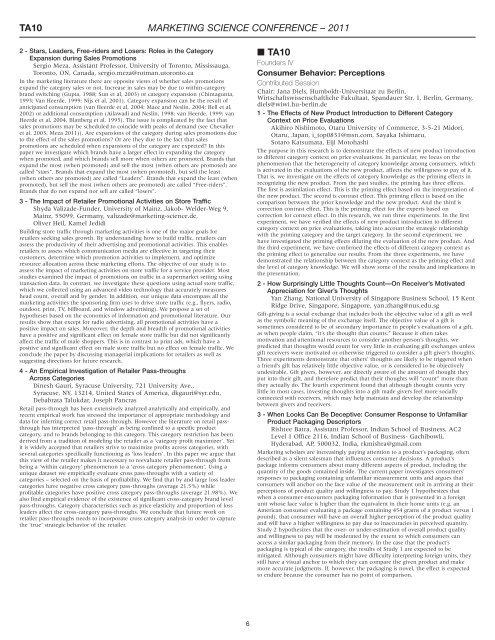Conference Sessions - Jesse H. Jones Graduate School of ...
Conference Sessions - Jesse H. Jones Graduate School of ...
Conference Sessions - Jesse H. Jones Graduate School of ...
You also want an ePaper? Increase the reach of your titles
YUMPU automatically turns print PDFs into web optimized ePapers that Google loves.
TA10<br />
2 - Stars, Leaders, Free-riders and Losers: Roles in the Category<br />
Expansion during Sales Promotions<br />
Sergio Meza, Assistant Pr<strong>of</strong>essor, University <strong>of</strong> Toronto, Mississauga,<br />
Toronto, ON, Canada, sergio.meza@rotman.utoronto.ca<br />
In the marketing literature there are opposite views <strong>of</strong> whether sales promotions<br />
expand the category sales or not. Increase in sales may be due to within-category<br />
brand switching (Gupta, 1988; Sun et al, 2003) or category expansion (Chintagunta,<br />
1993; Van Heerde, 1999; Nijs et al, 2001). Category expansion can be the result <strong>of</strong><br />
anticipated consumption (van Heerde et al, 2004; Mace and Neslin, 2004; Bell et al,<br />
2002) or additional consumption (Ailawadi and Neslin, 1998; van Heerde, 1999; van<br />
Heerde et al, 2004, Blattberg et al, 1995). The issue is complicated by the fact that<br />
sales promotions may be scheduled to coincide with peaks <strong>of</strong> demand (see Chevalier<br />
et al. 2003, Meza 2011)). Are expansions <strong>of</strong> the category during sales promotions due<br />
to the effect <strong>of</strong> the sales promotions? Or are they due to the fact that sales<br />
promotions are scheduled when expansions <strong>of</strong> the category are expected? In this<br />
paper we investigate which brands have a larger effect in expanding the category<br />
when promoted, and which brands sell more when others are promoted. Brands that<br />
expand the most (when promoted) and sell the most (when others are promoted) are<br />
called “stars”. Brands that expand the most (when promoted), but sell the least<br />
(when others are promoted) are called “Leaders”. Brands that expand the least (when<br />
promoted), but sell the most (when others are promoted) are called “Free-riders”.<br />
Brands that do not expand nor sell are called “losers”.<br />
3 - The Impact <strong>of</strong> Retailer Promotional Activities on Store Traffic<br />
Shyda Valizade-Funder, University <strong>of</strong> Mainz, Jakob- Welder-Weg 9,<br />
Mainz, 55099, Germany, valizade@marketing-science.de,<br />
Oliver Heil, Kamel Jedidi<br />
Building store traffic through marketing activities is one <strong>of</strong> the major goals for<br />
retailers seeking sales growth. By understanding how to build traffic, retailers can<br />
assess the productivity <strong>of</strong> their advertising and promotional activities. This enables<br />
retailers to assess which communication media are effective in targeting their<br />
customers, determine which promotion activities to implement, and optimize<br />
resource allocation across these marketing efforts. The objective <strong>of</strong> our study is to<br />
assess the impact <strong>of</strong> marketing activities on store traffic for a service provider. Most<br />
studies examined the impact <strong>of</strong> promotions on traffic in a supermarket setting using<br />
transaction data. In contrast, we investigate these questions using actual store traffic,<br />
which we collected using an advanced video technology that accurately measures<br />
head count, overall and by gender. In addition, our unique data encompass all the<br />
marketing activities the sponsoring firm uses to drive store traffic (e.g., flyers, radio,<br />
outdoor, print, TV, billboard, and window advertising). We propose a set <strong>of</strong><br />
hypotheses based on the economics <strong>of</strong> information and promotional literature. Our<br />
results show that except for radio advertising, all promotional activities have a<br />
positive impact on sales. Moreover, the depth and breadth <strong>of</strong> promotional activities<br />
have a positive and significant effect on female store traffic but did not significantly<br />
affect the traffic <strong>of</strong> male shoppers. This is in contrast to print ads, which have a<br />
positive and significant effect on male store traffic but no effect on female traffic. We<br />
conclude the paper by discussing managerial implications for retailers as well as<br />
suggesting directions for future research.<br />
4 - An Empirical Investigation <strong>of</strong> Retailer Pass-throughs<br />
Across Categories<br />
Dinesh Gauri, Syracuse University, 721 University Ave.,<br />
Syracuse, NY, 13214, United States <strong>of</strong> America, dkgauri@syr.edu,<br />
Debabrata Talukdar, Joseph Pancras<br />
Retail pass-through has been extensively analyzed analytically and empirically, and<br />
recent empirical work has stressed the importance <strong>of</strong> appropriate methodology and<br />
data for inferring correct retail pass-through. However the literature on retail passthrough<br />
has interpreted ‘pass-through’ as being confined to a specific product<br />
category, and to brands belonging to this category. This category restriction has been<br />
derived from a tradition <strong>of</strong> modeling the retailer as a ‘category pr<strong>of</strong>it maximizer’. Yet<br />
it is widely accepted that retailers strive to maximize pr<strong>of</strong>its across categories, with<br />
several categories specifically functioning as ‘loss leaders’. In this paper we argue that<br />
this view <strong>of</strong> the retailer makes it necessary to reevaluate retailer pass-through from<br />
being a ‘within category’ phenomenon to a ‘cross category phenomenon’. Using a<br />
unique dataset we empirically evaluate cross pass-throughs with a variety <strong>of</strong><br />
categories – selected on the basis <strong>of</strong> pr<strong>of</strong>itability. We find that by and large loss leader<br />
categories have negative cross category pass-throughs (average 21.5%) while<br />
pr<strong>of</strong>itable categories have positive cross category pass-throughs (average 21.98%). We<br />
also find empirical evidence <strong>of</strong> the existence <strong>of</strong> significant cross-category brand level<br />
pass-throughs. Category characteristics such as price elasticity and proportion <strong>of</strong> loss<br />
leaders affect the cross-category pass-throughs. We conclude that future work on<br />
retailer pass-throughs needs to incorporate cross category analysis in order to capture<br />
the ‘true’ strategic behavior <strong>of</strong> the retailer.<br />
MARKETING SCIENCE CONFERENCE – 2011<br />
6<br />
■ TA10<br />
Founders IV<br />
Consumer Behavior: Perceptions<br />
Contributed Session<br />
Chair: Jana Diels, Humboldt-Universitaat zu Berlin,<br />
Wirtschaftswissenschaftliche Fakultaat, Spandauer Str. 1, Berlin, Germany,<br />
diels@wiwi.hu-berlin.de<br />
1 - The Effects <strong>of</strong> New Product Introduction to Different Category<br />
Context on Price Evaluations<br />
Akihiro Nishimoto, Otaru University <strong>of</strong> Commerce, 3-5-21 Midori,<br />
Otaru, Japan, i_top0831@msn.com, Sayaka Ishimaru,<br />
Sotaro Katsumata, Eiji Motohashi<br />
The purpose in this research is to demonstrate the effects <strong>of</strong> new product introduction<br />
to different category context on price evaluations. In particular, we focus on the<br />
phenomenon that the heterogeneity <strong>of</strong> category knowledge among consumers, which<br />
is activated in the evaluations <strong>of</strong> the new product, affects the willingness to pay <strong>of</strong> it.<br />
That is, we investigate on the effects <strong>of</strong> category knowledge as the priming effects in<br />
recognizing the new product. From the past studies, the priming has three effects.<br />
The first is assimilation effect. This is the priming effect based on the interpretation <strong>of</strong><br />
the new product. The second is contrast effect. This priming effect is based on the<br />
comparison between the prior knowledge and the new product. And the third is<br />
correction contrast effect. This is the priming effect for the experts based on<br />
correction for context effect. In this research, we run three experiments. In the first<br />
experiment, we have verified the effects <strong>of</strong> new product introduction to different<br />
category context on price evaluations, taking into account the strategic relationship<br />
with the priming category and the target category. In the second experiment, we<br />
have investigated the priming effects diluting the evaluation <strong>of</strong> the new product. And<br />
the third experiment, we have confirmed the effects <strong>of</strong> different category context as<br />
the priming effect to generalize our results. From the three experiments, we have<br />
demonstrated the relationship between the category context as the priming effect and<br />
the level <strong>of</strong> category knowledge. We will show some <strong>of</strong> the results and implications in<br />
the presentation.<br />
2 - How Surprisingly Little Thoughts Count—On Receiver’s Motivated<br />
Appreciation for Giver’s Thoughts<br />
Yan Zhang, National University <strong>of</strong> Singapore Business <strong>School</strong>, 15 Kent<br />
Ridge Drive, Singapore, Singapore, yan.zhang@nus.edu.sg<br />
Gift-giving is a social exchange that includes both the objective value <strong>of</strong> a gift as well<br />
as the symbolic meaning <strong>of</strong> the exchange itself. The objective value <strong>of</strong> a gift is<br />
sometimes considered to be <strong>of</strong> secondary importance in people’s evaluations <strong>of</strong> a gift,<br />
as when people claim, “it’s the thought that counts.” Because it <strong>of</strong>ten takes<br />
motivation and attentional resources to consider another person’s thoughts, we<br />
predicted that thoughts would count for very little in evaluating gift exchanges unless<br />
gift receivers were motivated or otherwise triggered to consider a gift giver’s thoughts.<br />
Three experiments demonstrate that others’ thoughts are likely to be triggered when<br />
a friend’s gift has relatively little objective value, or is considered to be objectively<br />
undesirable. Gift givers, however, are directly aware <strong>of</strong> the amount <strong>of</strong> thought they<br />
put into their gift, and therefore predict that their thoughts will “count” more than<br />
they actually do. The fourth experiment found that although thought counts very<br />
little in most cases, investing thoughts into a gift made givers feel more socially<br />
connected with receivers, which may help maintain and develop the relationship<br />
between givers and receivers.<br />
3 - When Looks Can Be Deceptive: Consumer Response to Unfamiliar<br />
Product Packaging Descriptors<br />
Rishtee Batra, Assistant Pr<strong>of</strong>essor, Indian <strong>School</strong> <strong>of</strong> Business, AC2<br />
Level 1 Office 2116, Indian <strong>School</strong> <strong>of</strong> Business- Gachibowli,<br />
Hyderabad, AP, 500032, India, rkmishra@gmail.com<br />
Marketing scholars are increasingly paying attention to a product’s packaging, <strong>of</strong>ten<br />
described as a silent salesman that influences consumer decisions. A product’s<br />
package informs consumers about many different aspects <strong>of</strong> product, including the<br />
quantity <strong>of</strong> the goods contained inside. The current paper investigates consumers’<br />
responses to packaging containing unfamiliar measurement units and argues that<br />
consumers will anchor on the face value <strong>of</strong> the measurement unit in arriving at their<br />
perceptions <strong>of</strong> product quality and willingness to pay. Study 1 hypothesizes that<br />
when a consumer encounters packaging information that is presented in a foreign<br />
unit whose face value is higher than the equivalent in their home units (e.g. an<br />
American consumer evaluating a package containing 454 grams <strong>of</strong> a product versus 1<br />
pound), that consumer will have an overall higher perception <strong>of</strong> the product quality<br />
and will have a higher willingness to pay due to inaccuracies in perceived quantity.<br />
Study 2 hypothesizes that the over- or under-estimation <strong>of</strong> overall product quality<br />
and willingness to pay will be moderated by the extent to which consumers can<br />
access a similar packaging from their memory. In the case that the product’s<br />
packaging is typical <strong>of</strong> the category, the results <strong>of</strong> Study 1 are expected to be<br />
mitigated. Although consumers might have difficulty interpreting foreign units, they<br />
still have a visual anchor to which they can compare the given product and make<br />
more accurate judgments. If, however, the packaging is novel, the effect is expected<br />
to endure because the consumer has no point <strong>of</strong> comparison.

















